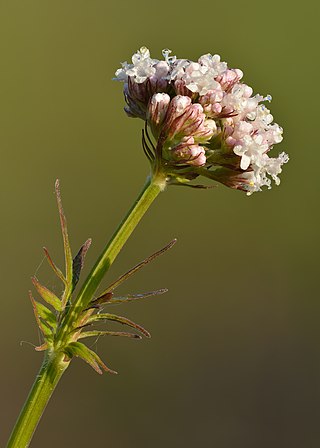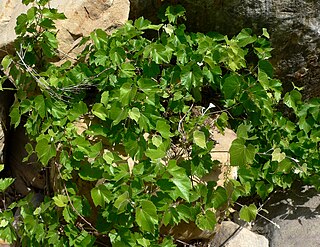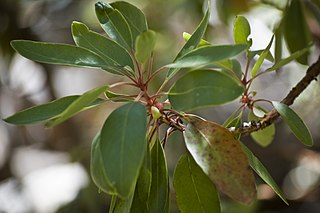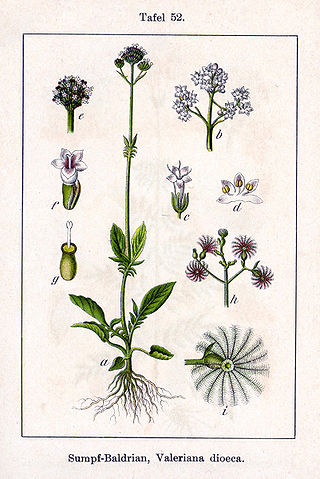
Valerian is a perennial flowering plant native to Europe and Asia. In the summer when the mature plant may have a height of 1.5 metres, it bears sweetly scented pink or white flowers that attract many fly species, especially hoverflies of the genus Eristalis. It is consumed as food by the larvae of some Lepidoptera species, including the grey pug.

Hesperocyparis arizonica, the Arizona cypress, is a North American species of tree in the cypress family Cupressaceae, native to the southwestern United States and Mexico. Populations may be scattered rather than in large, dense stands.

Valeriana is a genus of flowering plants in the family Caprifoliaceae, members of which may by commonly known as valerians. It contains many species, including the garden valerian, Valeriana officinalis. Species are native to all continents except Antarctica, with centers of diversity in Eurasia and South America.

Monardella is a genus of approximately 40 species of annual and perennial plants native to western North America from British Columbia to northwestern Mexico. They are grown for their highly aromatic foliage, which in some species is used for herbal teas. The two-lipped, tubular flowers are formed in terminal clusters and are most usually red, pink, or purple.

Harpagonella is a genus of flowering plants in the borage family. They are known as the grappling-hooks, because of the appearance and function of their fruits. The strange fruits are two small nutlets enclosed in a burlike calyx, which is armed with numerous spines covered in minute, hooked barbs. These diminutive, annual plants are found in sandy, clayey, and gravelly soils, and have small white flowers. This genus is native to North America, and is found in southern California, southern Arizona, northern Sonora, and the Baja California peninsula.

Valeriana celtica is a species of plant in the family Caprifoliaceae. It is also known as Alpine valerian and valerian spikenard. It is endemic to the Eastern Alps and to the Graian and Pennine Alps. It grows as a perennial herb 5 to 15 cm (2.0–5.9 in) tall. Along with Valeriana saxatilis and Valeriana elongata, it forms a clade of dioecious plants. Until the 1930s, it was extensively harvested for export to Asia for use in perfumes. The root has been used as a folk remedy as a nerve tonic.

Hesperocyparis glabra, known as the Arizona smooth bark cypress or smooth Arizona cypress, is a conifer native to the American Southwest, with a range stretching over the canyons and slopes in a somewhat wide vicinity around Sedona, Arizona. It is distinguished from Hesperocyparis arizonica by its very smooth, non-furrowed bark which can appear in shades of pink, cherry, and grey.

Vitis arizonica is a North American species of wild grape. It is a deciduous vine.

Arbutus arizonica, commonly known as Arizona madrone, is a tree species in the heath family that is native to the southwestern United States and northwestern Mexico. Its range extends along the Sierra Madre Occidental cordillera from the Madrean Sky Islands of southeastern Arizona and southwestern New Mexico south as far as Jalisco. It has been found in Sonora, Chihuahua, Durango, and Sinaloa, with one isolated population in Tamaulipas.

Valeriana occidentalis is a species of flowering plant in the honeysuckle family known by the common name western valerian. It is native to the western United States, particularly the northwestern quadrant, but it occurs as far south as Arizona and as far east as Colorado and South Dakota. It occurs in moist, forested mountain habitat. It is an erect herb growing 30 to 75 centimeters tall with whorls or opposite pairs of leaves at intervals along stem. The leaves are generally divided into lobes or are compound, with each leaf made up of a few oval-shaped leaflets. The inflorescence is a dense cyme of many funnel-shaped white flowers each 3 or 4 millimeters long with three long, protruding stamens. The fruit is a ribbed achene about half a centimeter long which may be tipped with the featherlike remains of the flower sepals.

Hesperocyparis nevadensis is a species of western cypress tree with the common name Paiute cypress native to a small area in the Sierra Nevada Mountains of California in the western United States. It was formerly known as Cupressus nevadensis.

Valeriana jatamansi, formerly known as Valeriana wallichii, is a rhizome herb of the genus Valeriana and the family Valerianaceae also called Indian Valerian or Tagar-Ganthoda, not to be confused with ganthoda, the root of Indian long pepper. It is an herb useful in Ayurvedic medicine used as an analeptic, antispasmodic, carminative, sedative, stimulant, stomachic, and nervine.
Grindelia arizonica, the Arizona gumweed, is a North American species of flowering plants in the family Asteraceae. It is native to the southwestern United States and northern Mexico, in the States of Coahuila, Chihuahua, Arizona, New Mexico, Utah, Texas, and Colorado.
Gutierrezia arizonica is a North American species of flowering plant in the family Asteraceae known by the common name Arizona snakeweed. It is native to Arizona in the United States and Sonora in northwestern Mexico.

Valeriana dioica, the marsh valerian, is a species of flowering plant in the genus Valeriana, native to Europe and Anatolia. It is typically found in calcareous fens. It is a dioecious species, with male and female flowers on separate individuals, and it is pollinated by small flies.

Valeriana pyrenaica, the capon's tail grass or Pyrenean valerian, is a species of flowering plant in the family Caprifoliaceae. It is native to Spain and France, and is a garden escapee in Ireland and Great Britain. A perennial shrub reaching 1.2 m (4 ft), it grows in the Pyrenees and Cantabrian Mountains, typically near water.

Valeriana phu, the golden spikenard, is a species of flowering plant in the family Caprifoliaceae, native to northern Turkey. A rhizomatous geophytic perennial reaching 1 to 1.5 m, it has a cultivar, 'Aurea', that is widely available from commercial suppliers.

Valeriana montana), the mountain valerian, is a species of flowering plant in the family Caprifoliaceae. Native to the mountains of Europe from east-central Spain, southern Italy, the Alps, the Balkans, and on to the eastern Carpathians, it is available from commercial suppliers.

















